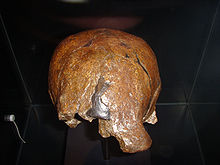Sangiran 2
Appearance
 | |
| Catalog no. | Sangiran 2 |
|---|---|
| Species | Homo erectus |
| Age | 0.7 - 1.6 mya |
| Place discovered | Indonesia |
| Date discovered | 1937 |
| Discovered by | G.H.R. von Koenigswald |
Sangiran 2 is a fossilized upper cranium of a Homo erectus (Homo erectus erectus). It was discovered in Sangiran, Indonesia by G.H.R. von Koenigswald in 1937.[1]
It is estimated to be between 0.7 and 1.6 million years old.[2][3]
Its characteristics include a long low plane behind the orbits and inwardly sloping sides.[3]
See also
- List of fossil sites (with link directory)
- List of hominina (hominid) fossils (with images)
References
- ^ G. H. R. von Koenigswald (1938). "Ein neuer Pithecanthropus-Schädel" (PDF). Proceedings of the Section of Sciences Koninklijke Nederlandsche Akademie van Wetenschappen (in German). 41 (2). Ámsterdam: N.V. Noord-Hollandsche Uitgeversmaatschappij: 185–192. Retrieved 10 May 2020.
- ^ Schwartz & Tattersall 2005, pp. 482–483.
- ^ a b Brown, Peter. "Sangiran". Peter Brown's Australian & Asian Palaeoanthropology. Retrieved 10 May 2020.
Bibliography
- Schwartz, Jeffrey H.; Tattersall, Ian (2005). The Human Fossil Record, Craniodental Morphology of Genus Homo (Africa and Asia). Volume 2. USA: John Wiley & Sons. ISBN 0-471-31927-9. Retrieved 1 May 2020. Online version shows only some pages.
External links
 Media related to Sangiran II at Wikimedia Commons
Media related to Sangiran II at Wikimedia Commons
